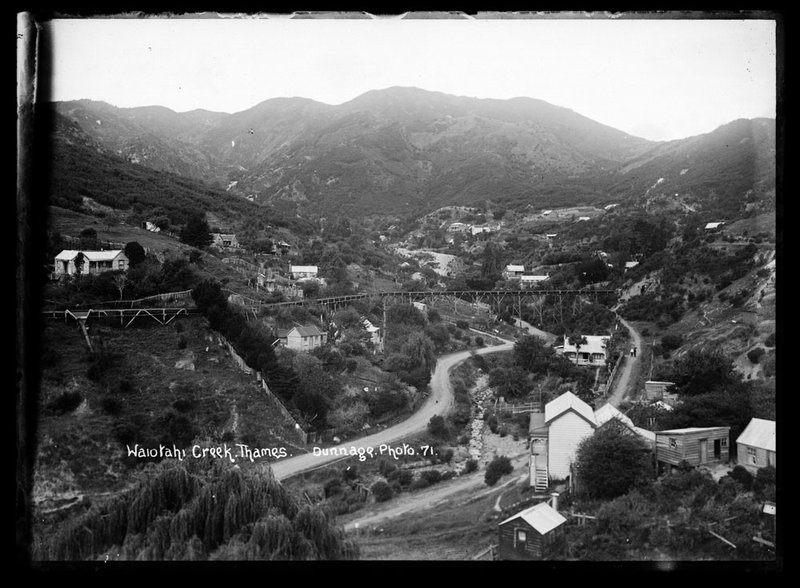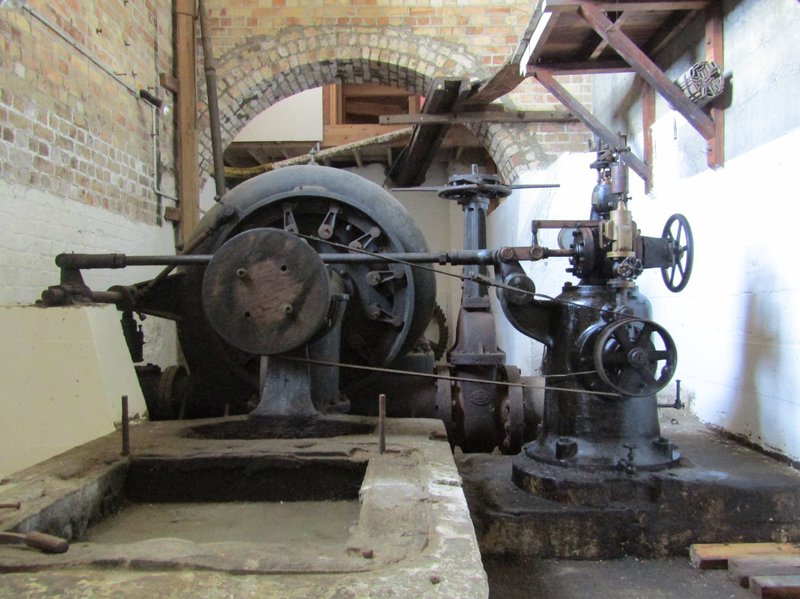The Thames Water Race was built in the 1870s to supply electricity and water to the booming goldmining town of Thames. Increased demand for electricity later saw the addition of a Francis Turbine and generator.
Power and water for Thames
Goldmining near the town of Thames began in 1867. The industry drew people to the region and the population soon reached 18,000. Stamper batteries, pumps and mine-head lifting equipment all required power, and water was needed for gold washing tables and as a public water supply for residents.
Government Colonial Engineer, William Carruthers C.E., presented various schemes to the Minister of Public Works for getting water from the Kauaeranga to the Thames goldfields. The recommended option was a high-level open-channel water race.
The race would take up to 90,000m3 of water per day from an intake on the Kauaeranga River, 33m above sea level, down to the town of Thames on the coast. The race was 15.5 km long and included 550m of tunnelling and 7.92 km of iron trough fluming over creeks and valleys at heights of up to 21m.
A series of contracts for the construction of the race were let from 1872.
Turning the water on
Water was first directed through the race on 16 January 1876, and the papers reported that the water was conveyed in ‘splendid style’.
The majority of ore crushing batteries changed from steam power to water power using turbines and Pelton wheels.

Looking up Waiotahi Creek,Thames, towards hills. Showing houses and a flume carrying water, part of the water race coming from the Kauaeranga Valley, constructed in 1878 and built to supply water to Thames to service the mining industry. Auckland Libraries Heritage Collections 35-R1431
Public electricity supply for Thames
With the abolition of provincial government in 1876, the Thames Borough took over management of the water race. As well as generating power for gold mining machinery, the Borough also had an interest in providing electric power to residents. The idea of a hydro scheme was raised in 1906 but was dismissed because of low water flows in local creeks.
In 1912, ratepayers voted to approve a loan of £14,000 to provide electricity for the borough. With Public Works Department approval in 1913, Turnbull and Jones Ltd. were contracted to supply two, two-cylinder Hicks Hargreaves diesel engines and British Westinghouse 460v DC generators. These were located at a purpose-built power station building on the corner of Sealey and Mackay Streets. Unfortunately, complaints about ground vibrations meant that only one of the diesel engines could be used at any one time.
Public electricity supply commenced on 24 April 1914. Street lighting was turned on and power provided to customers for lighting and heating from 5pm to midnight every evening. Initially there were 70 applications for connections. Within three months this number had increased to 153.
Francis turbine and generator
By 1915, goldmining in Thames was coming to an end and surplus water was now available from the water race. In addition, the Hauraki Pump building in Bella Street which had pumped water out of the mines was no longer in use. Taking advantage of this, the Borough decided to install a Francis Turbine and generator at the Bella Street Pumping Station. This would allow the Borough to supply additional electricity to residents.
Tenders were called, but because of wartime conditions there were long delivery times for the Francis Turbine from Pelton Wheel Co. in USA, and the 80-volt DC generator from Bruce Peebles & Co. Ltd. of Edinburgh. To meet the demand while awaiting the installation, a temporary generator was installed at the nearby Waiotahi mine. This allowed for the increasing demand and provided a continuous daytime power supply, except for Sundays.
The Borough Council secured the lease of the Bella Street pump building, and by November 1916, the Francis turbine and generator were installed and in service. A 762mm cast iron pipe brought water from the nearby 4,546 m3 Waiokaraka Reservoir utilising a maximum available head of 39.6m.
From time to time, flooding and slips damaged the water race, putting it out of service. In 1917, one of the diesel engines at Sealey Street was moved to the Bella Street Pump station to serve as a back-up source of power. The second Sealey Street diesel engine was sold.
By January 1918, the changeover from the Sealey Street station to Bella Street was complete.
Thames Valley Electric Power Board
The Electric Power Boards Act, 1918, allowed districts to undertake local electrification schemes, managed by a board of elected ratepayers. The Thames Valley Electric Power Board formed in 1921. They connected to the AC power supply available from the Horahora hydro station on the Waikato River and brought electricity to Paeroa.
The Thames Borough’s Bella Street Pump House, although limited in capacity, already provided electricity for Thames.
The Power Board constructed a 3.3 kV line from their Parawai Substation, just south of Thames, to the Borough’s hydro station at the Bella Street Pump house building. This allowed the installation of a synchronous motor to drive the turbine and DC generator when no water was available. In the event of a failure of the Horahora supply, the synchronous motor could be used to provide an AC supply from the hydro turbine.
In October 1931 a problem of misalignment of the hydro set occurred, preventing any of the machines from running. The Thames Valley Electric Power Board offered to take over the whole of the Thames Borough supply, but the Borough resisted. At that time the Borough were in difficulties. When it appeared that they might default on loan repayments, the Government brought in a commissioner to take over the Borough’s affairs. The changeover to AC power supply was completed, and a new alternator was ordered and installed in 1934.
Decommissioned
By 1946, the water race had become increasingly difficult to maintain and was no longer needed, as water for the borough was now delivered via a pipeline. The Bella Street Hydro station was closed, and the water race was decommissioned and demolished the following year.
Photo below: The Francis Turbine. The Bruce Peebles 80V DC generator is behind (see picture below). The synchronous alternator would have been connected to the flange in the foreground. The hand wheel in the centre controlled the inflow and the rod mechanism and the rod mechanism from the right side hand wheel connected to the turbine wicket gates, maintained the turbine speed from the belt drive.

The Francis Turbine. Photo: S La Roche, November 2016.

The Bruce Peebles 80V DC generator looking back towards the Francis Turbine and inlet control valve and pedestal behind. Photo: S La Roche, November 2016.
More Information
References
Mill, A . 'The Engineering History of Electric Supply in New Zealand'. Thames Borough Electricity Department, Electric Supply Authorities of New Zealand, 1958.
Rennie, Neil. Power to the People. Wellington: Electricity Supply Assn. of New Zealand, 1989.
Wilton, David. 'The Thames Water Race (1876-1947)', The Treasury Journal, Vol. 2, (2009). The Coromandel Heritage Trust.
'Thames Goldfields Water Supply. Colonial Engineers Report.' Daily Southern Cross, May 6, 1872, p3.
'The Thames Water Supply - The Water Running'. New Zealand Herald, January 17, 1876, p2.
Location
Bella Street Pump House Museum, corner of Bella and Cochrane Streets, Thames.
Access
Contact the Bella Street Pumphouse Museum for opening hours and admission charges.
This entry was prepared by John La Roche
Page last updated: 04 September 2019
